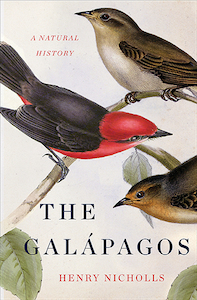The many ways in which Galápagos Islands are extraordinary is a subject that has been taken up by naturalists, novelists, and explorers for centuries. From Darwin and Melville to William Beebe to the Grants, various aspects of the islands’ geology, flora, and fauna have been chronicled, often with superb skill and profound insight, in different forms and for diverse purposes. However what has, it may be argued, been given too little attention in any one single book is the overall natural history of the islands that comprise the Galápagos archipelago; which is why Henry Nicholls’ recently published book The Galápagos; A Natural History is such a very welcome addition to the corpus of works pertaining to the islands.
Written as a general introduction to the natural history of the islands, Mr. Nicholls’ begins not with the usual noteworthy birds and reptiles – the finches, iguanas, and tortoises – but rather with the geology and oceanography of the islands; a very astute decision on his part indeed. For by beginning in this way, the reader is given the most solid of foundations upon which to build his or her understanding of just what it is that makes these islands so unusual; what makes them literally places of both convergence and divergence in a remarkable variety of ways.
From there, Mr. Nicholls moves into examinations of the seabirds, plants, invertebrates, land birds, and reptiles of the islands. Taking up each of these subjects with the acumen of an accomplished naturalist, he nevertheless keeps his tone delightfully conversant so as to ensure that all interested – regardless of background in the subject – may find what he has written as enjoyable to read as it is informative.
However what many may initially find most unusual (then subsequently come to see as particularly valuable) about The Galápagos; A Natural History is its final three chapters, titled Humans: Part I, II, and III respectively. In these Mr. Nicholls examines the effects, both direct and indirect, intentional and otherwise, that have been brought about on and around the islands by the centuries of human visitation – and more recently habitation.
As expected, these chapters are replete with stories concerning the ravages visited upon the various island by invasive species; however they are also filled with information about attempts – some successful, others not but still ongoing – to eradicate such species. Yet they also contain a wealth of information about the national, regional, and global politics surrounding the islands, as well as the economic issues that have become particularly significant in the past few decades. Indeed, such an expansive yet nuanced approach to examining the effects of humans upon the islands is unusual in an introductory-level work of natural history, but it is one that gives it an an additional and highly valuable dimension for which Mr. Nicholls should be heartily commended.
The Galápagos; A Natural History is a book that should be on the reading table of all those interested not only in the natural history of the Galápagos Islands but by everyone who wishes to expand their perspective upon the subject of natural history itself – as well as, of course, those who simply enjoy reading interesting and well-written books in general.
 Title: The Galápagos; A Natural History
Title: The Galápagos; A Natural History
Author: Henry Nicholls
Publisher: Basic Books
ISBN 13: 978-0-465-03597-7
Format: hardcover
Date: 8 April 2014
In accordance with Federal Trade Commission 16 CFR Part 255, it is disclosed that the copy of the book read in order to produce this review was provided gratis to the reviewer by the publisher.
